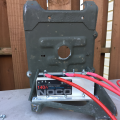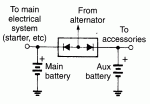stationjj
Member
- 263
- 1
- 18
- Location
- Middle Tennessee
Update on adding 3rd battery and battery isolator to my M1009. I think I got everything installed correctly. I did a test and nothing shorted out, or blew up, and my primary battery bank seems to re-charge as normal.
Overall the install was easy and straight forward even for an amateur DC Electrical guy. I love projects like these on the CUCV. I always learn something.
The hardest issue I had was finding a mounting place for the isolator near the current batteries on the passenger side. I am using a NOCO 140 amp Isolator I got off Amazon. I ended up mounting the isolator under the front battery tray. It was a tight fit, and I had to create plate for the battery isolator to mount too. Picture Below.
I do have a few questions concerning isolator.
I how can I verify the isolator is recharging 3rd battery? Add a volt meter and monitor? I plan to add a digital volt meter.
In recharging the isolator gives priority to Primary battery before the 2nd battery? My thought is yes. Want to verify.
I wanted to update this post as future reference. When I started this project I found the other posts confusing for my level of DC electrical knowledge.

Thanks
John
Overall the install was easy and straight forward even for an amateur DC Electrical guy. I love projects like these on the CUCV. I always learn something.
The hardest issue I had was finding a mounting place for the isolator near the current batteries on the passenger side. I am using a NOCO 140 amp Isolator I got off Amazon. I ended up mounting the isolator under the front battery tray. It was a tight fit, and I had to create plate for the battery isolator to mount too. Picture Below.
I do have a few questions concerning isolator.
I how can I verify the isolator is recharging 3rd battery? Add a volt meter and monitor? I plan to add a digital volt meter.
In recharging the isolator gives priority to Primary battery before the 2nd battery? My thought is yes. Want to verify.
I wanted to update this post as future reference. When I started this project I found the other posts confusing for my level of DC electrical knowledge.

Thanks
John
Last edited:



